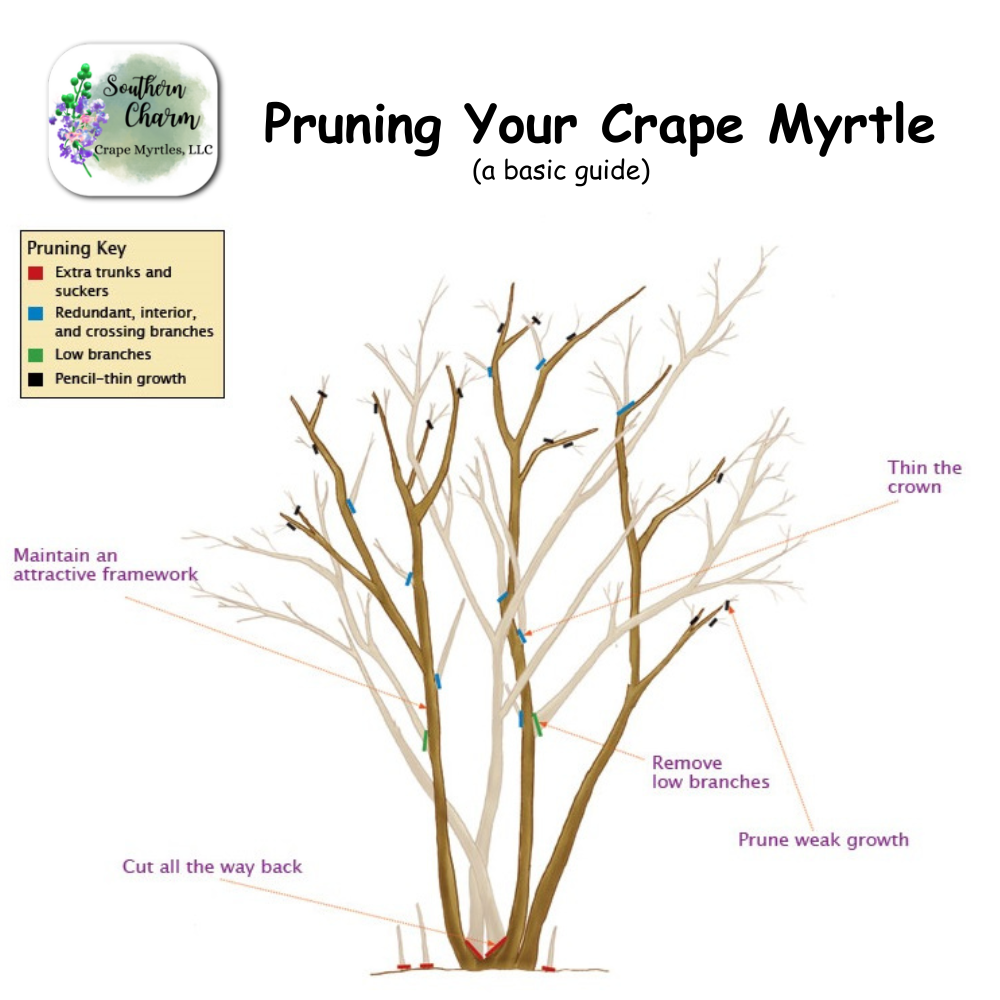Crape Myrtle Pruning
✂️Crape Myrtle Pruning🌱 – The Secret to Bigger Blooms & Healthier Trees!
Want to unlock the full potential of your crape myrtles? The secret is all in the pruning! Proper Crape Myrtle Pruning not only keeps your trees looking neat and well-shaped, but it also encourages bigger, more vibrant blooms all season long. Whether you're a beginner or a seasoned gardener, learning the right pruning techniques will help you maintain healthy, thriving crape myrtles for years to come!
So, when should you prune? The best time for Crape Myrtle Pruning is in late winter to early spring, just before new growth begins. This ensures that your tree puts all its energy into producing fresh, strong branches and an abundance of stunning blooms. But don’t go overboard! Too much pruning (a.k.a. "crape murder") can weaken your tree, reducing the number of flowers and leaving it looking spindly and sad.
For optimal results, focus on removing dead or weak branches, thinning out crowded areas, and trimming away suckers at the base. This allows for better air circulation, preventing disease and promoting strong, healthy growth. If you're shaping your crape myrtle into a small tree or keeping it compact, strategic pruning will help maintain its ideal size and form.
The golden rule? Never top a crape myrtle (crape murder)! This common mistake leads to knobby, weak growth and fewer blooms. Instead, prune selectively to enhance its natural beauty. If you're growing a miniature or dwarf crape myrtle, gentle pruning will keep it looking lush and full while still encouraging tons of colorful flowers.
Crape Myrtle Pruning doesn’t have to be intimidating! With the right tools and a little know-how, you'll have gorgeous, well-maintained trees that put on a spectacular floral show year after year. Whether you're shaping a graceful, multi-trunk tree or keeping your compact varieties tidy, pruning is the key to success.
At Southern Charm Crape Myrtles, we're passionate about helping gardeners grow their best crape myrtles. That’s why we’ve created an easy-to-follow pruning guide filled with expert tips and tricks to make sure you're getting the most blooms possible!
Ready to master Crape Myrtle Pruning? Check out our expert guide and start pruning your way to bigger, better, and more beautiful blooms today! 🌸✂️

How, Why & When Should I Prune My Crape Myrtles?
These are questions we're asked all the time. First, let's learn a bit about the crape myrtle itself.
Basic Facts
- Crape myrtles are deciduous hardwoods, meaning they drop their leaves in winter and emerge from dormancy in Spring.
- Crape myrtles ONLY Bloom on new growth.
- Pruning encourages new green growth in Spring, increasing your flower yields.
- Pruning in winter when they are dormant is less stressful for the plants.
- Pruning is NOT absolutely necessary. You crape myrtles can grow naturally and still be covered in flowers.
- Crape myrtles are extremely tough and resilient plants so they are the ideal for pruning and even bonsai.
The Main Reason's Crape Myrtles are Pruned
- Control shape and size
- Encourage new spring growth
- Increase flower yield with very little effort
- Remove unhealthy or unwanted branches
Tools You'll Need
- Gloves
- Loppers
- Pruning Sheers
- Chainsaw*
*A chainsaw is only needed for major projects, such as when large branches are hanging precariously over a roof etc. You'll see chainsaws used for "crape murder," which we will try to avoid. But sometimes aggressive pruning is necessary to save both property and the life of the plant.
When Should I Prune?
Traditionally pruning is done in winter when the plant is dormant. This can be early winter after the plant has dropped all its leaves, or late spring right before the plant emerges from dormancy. The key is to prune when the plant is dormant.
When we prune, we are creating a wound. When it's dormant it is far less stressful for the plant.
But can we prune them when they're in an active state of growth? The simple answer is YES. Just keep in mind that your crape myrtle is going to have to spend energy repairing the wound, potentially fighting off unwanted pathogens that are active during the spring and summer months. Also, dehydration can become an issue if too much of the plant is removed during an active state of growth.
So, if you find yourself pruning a little late in spring, or even in the height of summer blooming season, just keep in mind that a little extra care will go a long way.
- Apply any number of protective products, from neem oil to horticultural paint, to cut branches. This will help kill pathogens and protect the tree.
- For the following 1-2 weeks, keep the soil moist, but not soaking wet. You'll notice that some of the remaining branches and leaves may or may not wilt. This is typically caused by mild dehydration.
- Once you see new growth begin again, go ahead and lightly Fertilize. This little extra boost will help them quite a bit.
Is Pruning Really Necessary?
Absolutely not! A healthy crape myrtle is going to naturally put on lots of new spring growth and bloom like crazy in summer. Flowering and going to seed every year is a natural part of their reproductive cycle.
What Happens When I Prune?
Pruning controls shape and size of your plant. It also encourages new growth and branching. And since crape myrtles only bloom on new growth, pruning alone will increase your flower yield.
Again, always keep in mind that where each cut is made the plant will have then tendency to branch, become much more full, thick and produce flowers.
🫨Don't Panic, it WILL Grow Back!
Let's consider the mature size of the tree/bush and the look you're going for...
- Are you planting a single tree for shade?
- Do you want a single trunk or multi-trunk tree?
- Do you want a privacy hedge?
- Would you like to line your driveway, or property line?
- Are you creating a small border?
- Will you be using them as perennial, weeping hanging baskets?
Single Trunk Tree
Although some varieties are easier to grow as single trunk trees, ANY crape myrtle, from the tallest Standard to the smallest Micro-Mini can become a single trunk tree. It's all a matter of pruning.
Choose the strongest, most upright trunk and remove the rest below the soil line. The younger they are the better. The shoots will try to grow back. This is normal and expected. Although chemical products, such as Sucker Punch claim that they kill the "suckers" (or in this case side shoots), they are essentially herbicides and will damage your tree. We do not recommend them. Try them at your own risk. We recommend a high-quality light blocking weed cloth used around the remaining trunk with a 3-6in layer of mulch (any kind), over the weed cloth. Without light, the shoots will wither and die, leaving your tree a single trunk to which it can focus its energy. Remove any unwanted lower branches as they grow and you're all set.
*The vast majority of our plants are single trunk*
Multi-Trunk or Natural Look
You may have noticed crape myrtles in your area begin multi-trunk. This can be achieved in two ways.
First, you can purchase more than one tree and plant them in the same hole. This is the fastest way to achieve the desired look and what's most commonly practiced in the landscape business.
Second, you can let the shoots or "suckers," grow from the roots. Over time they will become additional trunks. All crape myrtles like to send up shoots from the roots, it's just their nature. Although some varieties tend to do so more readily than others, they ALL will eventually. This method creates the natural look, which over the years has become extremely popular. Mostly because it takes little to no maintenance and the plants end up thick and beautiful.
*Also, if you choose not to prune and leave the dried seed pods on the plant, you'll be providing a source of food small birds over winter!*
Shade Trees
Medium and Standard crape myrtles are normally used for providing shade. Very little pruning is required. Simply remove lower branches to expose the trunk(s) and give them a nice vase shape. Interior branches (see diagrams above) can be removed if possible.
As these trees naturally become very tall it will be nearly impossible to reach the top branches safely, so try not to worry about pruning those. If you leave these branches alone to grow naturally, they WILL FLOWER NEXT YEAR.
Privacy Hedges
Whether you have a Dwarf, Medium or Standard crape myrtle, they can all be used for privacy (although some varieties are naturally better suited than others of course). See Plant Spacing for more information.
The first few years it's best to let them grow naturally. Let them send up new shoots from the roots, called "suckers," to become nice, thick multi-trunk plants. You can give them a little haircut to control an unruly branch or help encourage shape, but even that is typically not necessary.
Once they reach a reasonable height or even a little on the tall side: the height is completely determined by you. You can begin regular pruning.
Small Borders
Small borders, such as those for a sidewalk or deck, are typically Bijou Micro Mini's, Miniatures or Dwarfs. Since we want these to grow thick and full, it's ideal to prune them each winter, even if it's the first year in their new home.
Like all other crape myrtles, pruning will encourage branching, giving nice thick borders.
Even if it's just a couple inches each winter, keep pruning and watch them become thicker and fuller year after year.
Micro Mini's, Miniatures, Hanging Baskets and Bonsai
We're very often asked how to prune a Micro Miniature and Miniature crape myrtle. The answer is exactly the same as a large crape myrtle: give them a nice shape to encourage branching, new green growth and flowering.
Mounding and weeping miniatures need very little pruning. Normally trimming off the last couple inches of each branch is plenty. It encourages branching, and the extra available sunlight will encourage dormant nodes to sprout entirely new branches. This holds true with all other shapes and sizes of crape myrtles too.
The same principles apply for Hanging Baskets: cut an inch or two off each branch to encourage thicker, longer branching in Spring.
When pruning for Bonsai, the only limit is your imagination. Cut, twist, bend, wrap, crape myrtles can handle it all. Crape myrtles, especially Micro-Mini's and Miniatures, are often referred to as instant bonsai. With their naturally small leaves, delicate flowers and unusual trunks you can let your creativity blossom.
"Dead Heading"
"Dead heading simply refers to the removal of spent flower clusters before they can fully develop into seed pods. Dead heading crape myrtles encourages your plants to produce a whole new round of flowers. Snip off those faded flower clusters with clean shears just above fresh leaves or buds, and watch your shrub redirect its energy for a second (or third!) colorful show. Come late summer, this quick trim keeps your garden popping.
But hold off on cutting those seed pods in winter—those little capsules, as our pics show, are a buffet for finches and sparrows, giving birds a cozy meal when food is scarce.
And then...there's Crape Murder
"Crape Murder" simply refers to excessive pruning. Normally when a chainsaw is used to cut branches 3in+ in diameter from over half the tree and you're left with an unnatural, gangly trunk. That's crape murder. The results can go either way: the tree can bounce back, put on over 10ft of new growth, branch and flower like crazy. The alternative is it will send up a few thin branches while the rest of the trunk is being devoured by lichen, fungi and insects.
What we can tell you for absolute certain, is that if crape murder is continued, year after year, the plant will become so unhealthy that it WILL die. So, let's try to avoid that as much as we can.
Crape murder is easy to avoid: Just give them a light trim every winter or every other winter. This will not only be easier on your tree, but it will also allow you to remove any diseased or broken branches and encourage new growth and ultimately maintain a healthy tree that can easily out live us.
Sometimes crape murder is unavoidable. Perhaps it's leaning over a structure a little too much, or a large part of the canopy has developed a disease, or half of it broke off in a hurricane. Whatever the reason, crape myrtles CAN and DO recover from an aggressive prune. In many cases we've seen 30+yr old trees that had to be cut all the way to the ground. And you know what? They came back from the roots with a hundred tiny shoots that grew over 10ft+ in a single growing season. Just remember, if crape murder is required, cover the wounds in a horticultural protective paint or neem oil to help prevent dehydration and infection from unwanted pathogens. Also, new growth can take much longer after the shock of crape murder (even if it's done while the plant is dormant), so give it an extra month or so to put on new growth. Once it is evident that the crape myrtles have indeed survived by putting on several inches of new growth, go ahead and begin a regular fertilization regimen.
If You've Made it this Far, You've Probably Learned More About Pruning than You Ever Wanted to!
In Summation:
- There's no strict right or wrong way to prune crape myrtles. Some ideas and methods are simply better than others.
- Crape myrtles are extremely forgiving. If you make a mistake, so what?! Like hair, it WILL grow back.
- Their resilience makes them ideal for just about any landscaping purpose.
- Have fun with it. Crape myrtles are intended to add beauty and dynamic life to your own personal outdoor oasis. So don't stress.
- Just remember, if you run into any snags we're here to help along the way.


